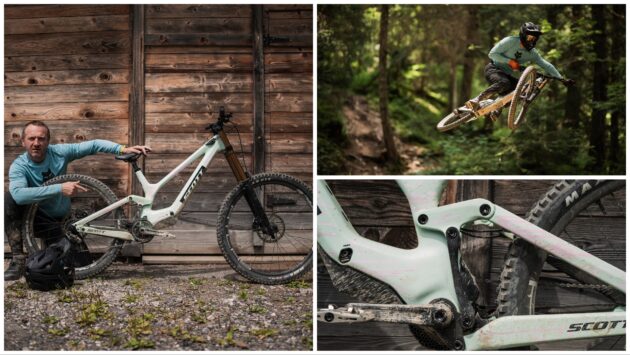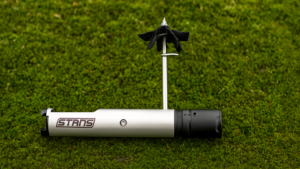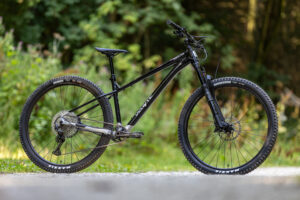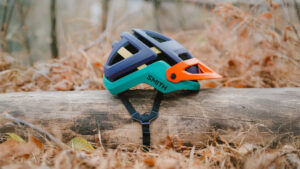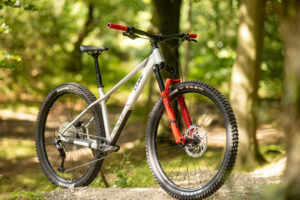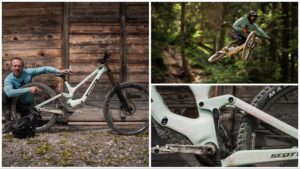The stakes couldn't be higher at the top levels of downhill racing, so Scott's latest Gambler hedges its bets with a bike that can be configured pretty much any way you want.
The new Scott Gambler has a 6-bar linkage, hides its shock inside the frame, and can be configured in 36 different ways – but is it too complicated for the weekend warrior?
The new Scott Gambler is a multi-faceted, shapeshifting race platform built to deliver at the highest echelons of downhill. Ironically, with so many parameters adaptable by the end user, Scott has shortened the odds of failure, and made this Gambler as safe a bet as possible.
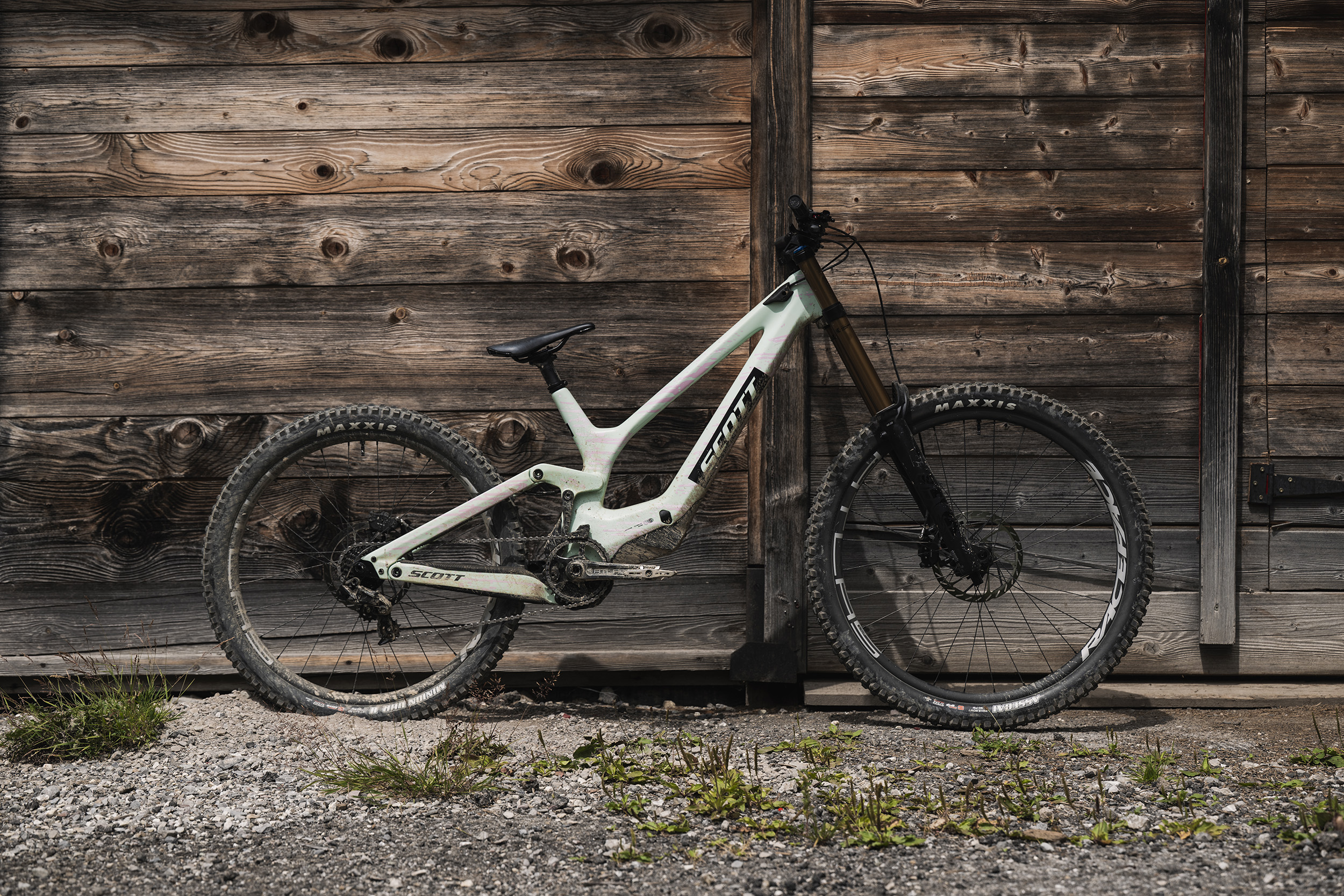
The hidden shock on the new Scott Gambler will surprise no one, but it does have a few unexpected tricks up its sleeve.
Scott Gambler need to know
- World Cup-ready downhill race bike boasting an array of adjustments
- Carbon frame with Integrated Suspension Technology (AKA a hidden shock)
- Six-bar linkage
- 210mm rear travel (depending on chainstay length)
- MX and 29in wheel compatibility (complete bikes come MX)
- 5 frame adjustments including chainstay, reach, progression and BB height
- Guided internal cable routing and dedicated entry ports
- Integrated sagometer also tells you how much travel you’re using
- 3 sizes – M, L, XL
- Two models – Gambler RC (£8,849) and Gambler 10 (£5,699)
Racing doesn’t do certainties though, and while Canyon and, to a greater extent Orbea, have enjoyed notable success with their respective downhill bike launches this season, the planets have not aligned for Scott Factory Racing and its two stars, Benoit Coulanges and Ethan Craik. From what I’ve seen and experienced riding the bike, that’s no reflection on the performance of the new Gambler, and with the World Cup resuming in Les Gets this weekend, on home soil, perhaps Scott’s luck is about to change?
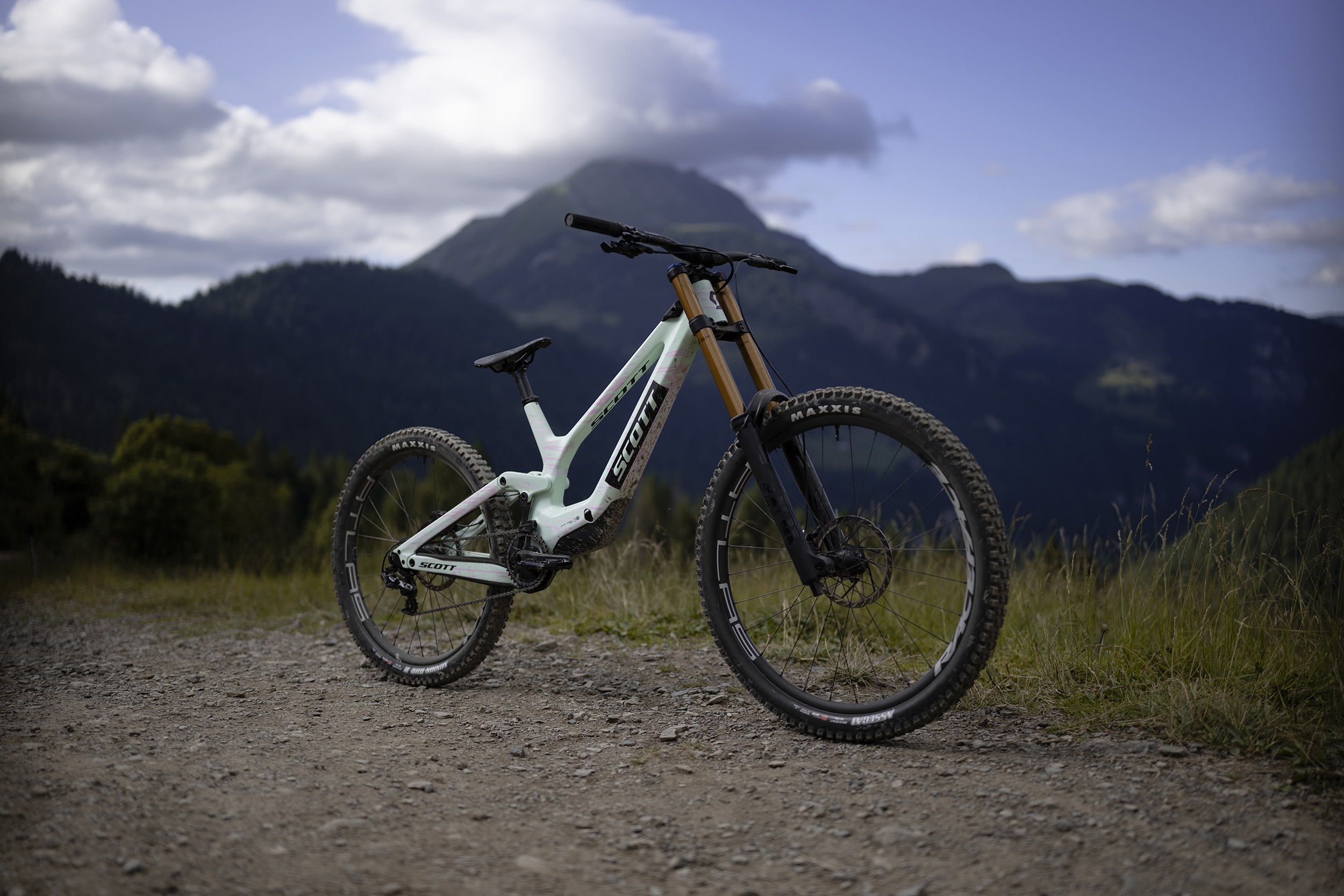
The new bike is both clean and good looking, with all the adjustments neatly integrated into the frame.
But I’m no bookie. My job is to try and convey what this ultra-adaptable machine is like to ride for an average squid. And to that end I travelled out to Chatel, in the Portes du Soleil, for two days aboard the new Gambler, operating out of the very same pit set-up enjoyed by the full factory athletes. It doesn’t get much better than that.
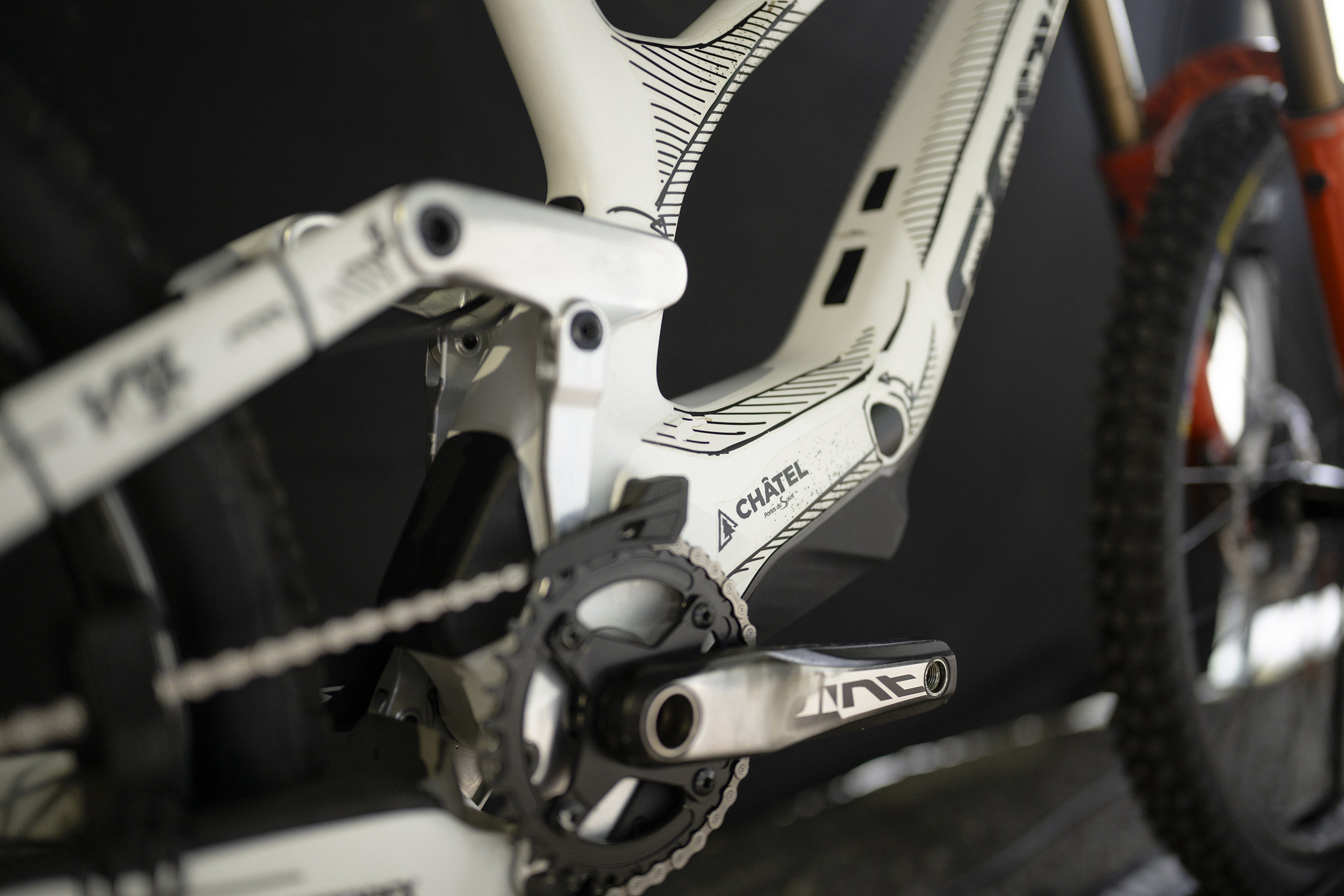
Benoit Coulanges notched up 20 Everest descents on this mule during the off-season development process.
Frame
Scott acquired the Swiss brand Bold in 2019 and shortly after embarked on a program of applying its signature hidden shock technology to the Scott MTB range. The first bike to have its damper concealed within the carbon chassis was the Spark in 2021, and four years later this new Gambler completes the adoption process.
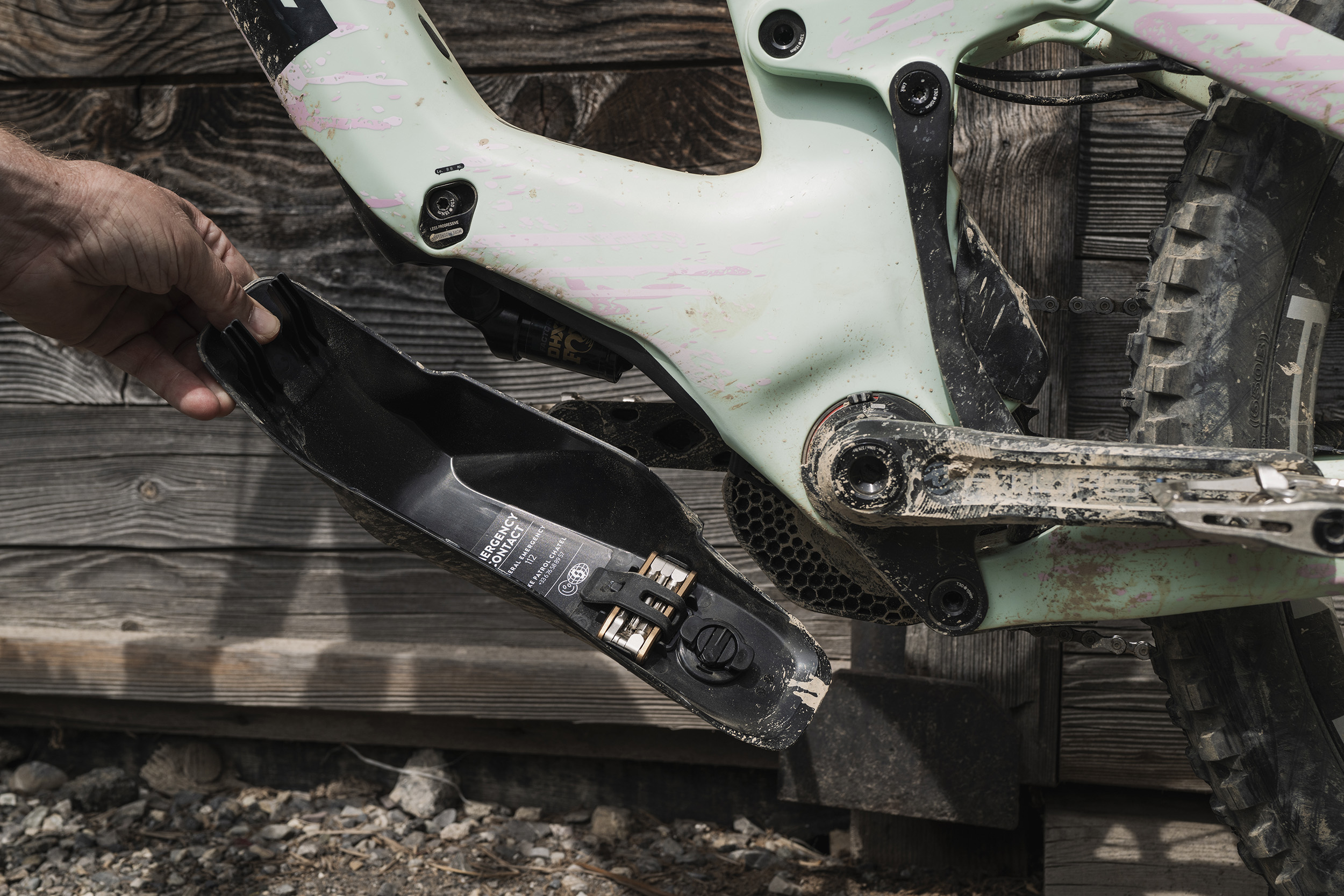
Removing the shock cover is quick and easy thanks to the twist-lock, and a hidden multi-tool helps when making damping adjustments and cockpit tweaks.
Not that the two bikes share much in common when it comes to the position or operation of the shock. More travel and bigger shocks have increased the packaging challenge considerably, so the design of the Gambler owes much to the engineering work done on the Ransom enduro bike.
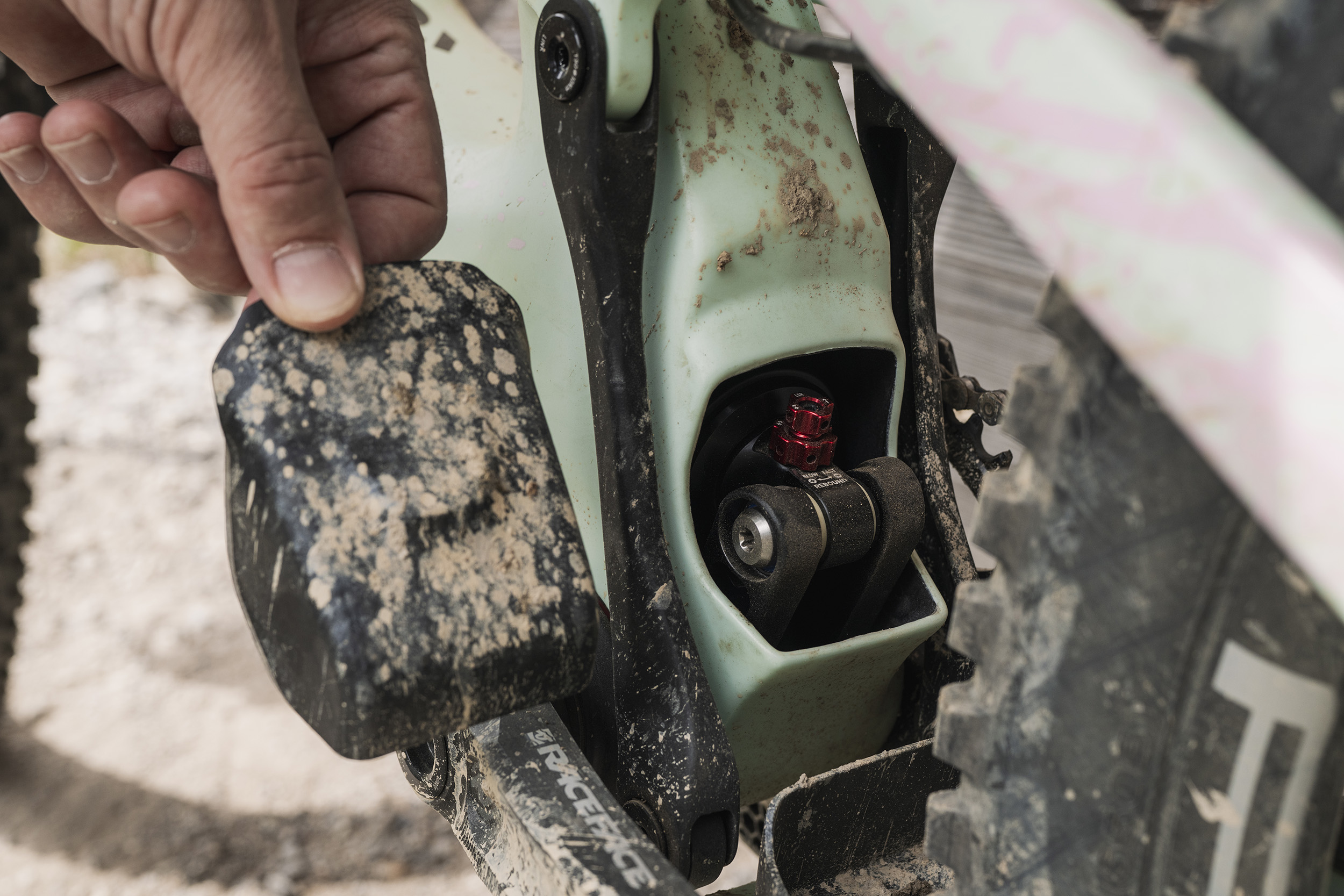
The small rear cover provides access to the rebound adjusters.
That particular model has 170mm of travel achieved through a complex six-bar linkage design, and it’s this basic layout that forms the backbone of the Gambler. The shock itself sits forward of the bottom bracket capped by large removable covers. So large are they, and so exposed is the shock with them removed, that it might be more accurate to describe the shock as sheltered, rather than concealed, within the frame. Making the shock easily removable by mechanics is, of course, an important consideration with any race bike, and the Gambler’s bits can be whipped out quicker than a rugby player on a pub crawl.
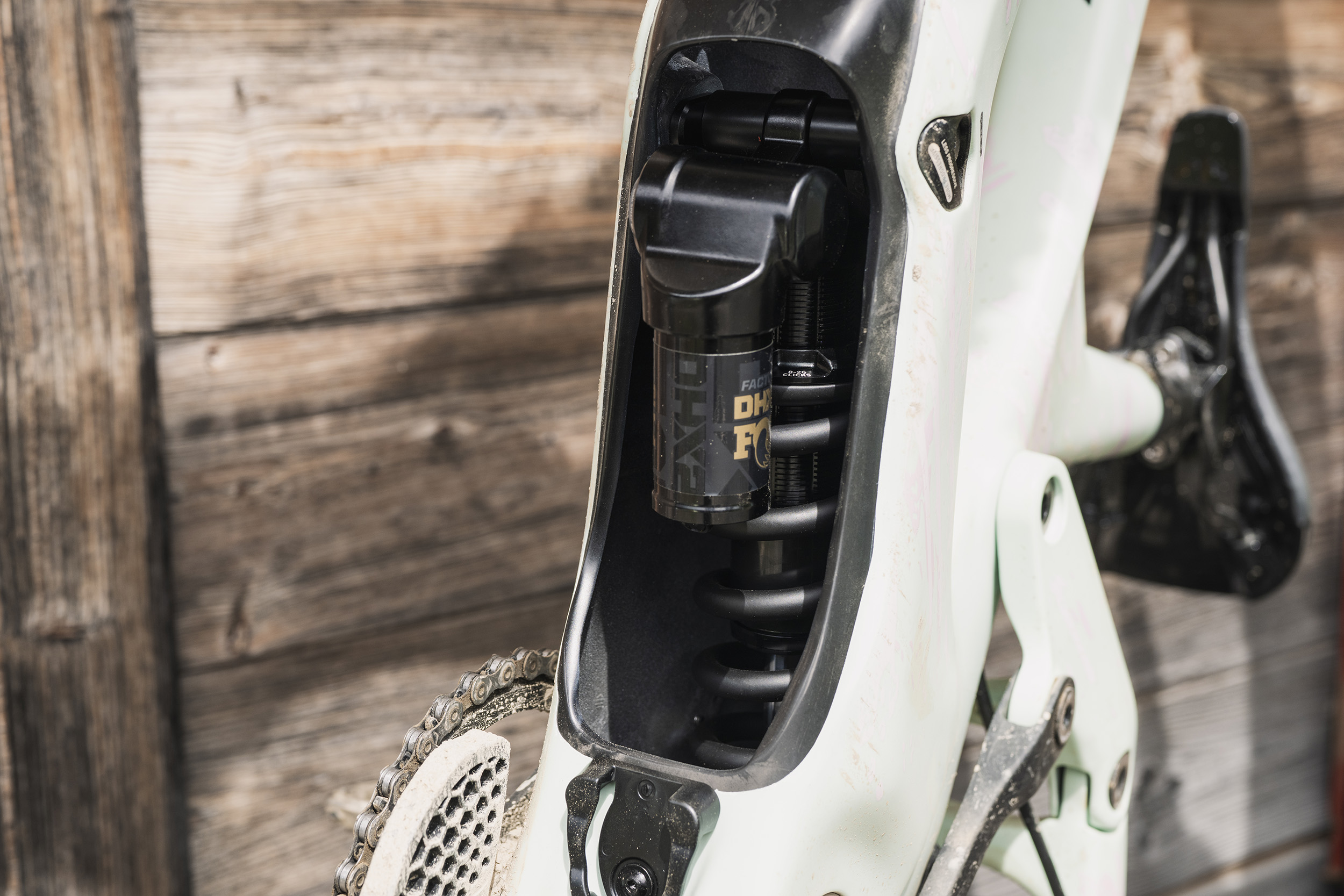
Coil shocks are standard on both complete builds, but team riders run a mix of air and coil.
Sufficient space has been provided for both coil and air shocks, and Scott is at pains to point out how many shocks are compatible with the new frame. Within the race team, there is a fairly even split between racers on coil shocks and those on air shocks, but both stock builds come with the coil option. For the record, Ethan runs an air shock, the long wheelbase, low BB, and more progressive shock setting, while Benoit differs with a coil, and the high BB option.
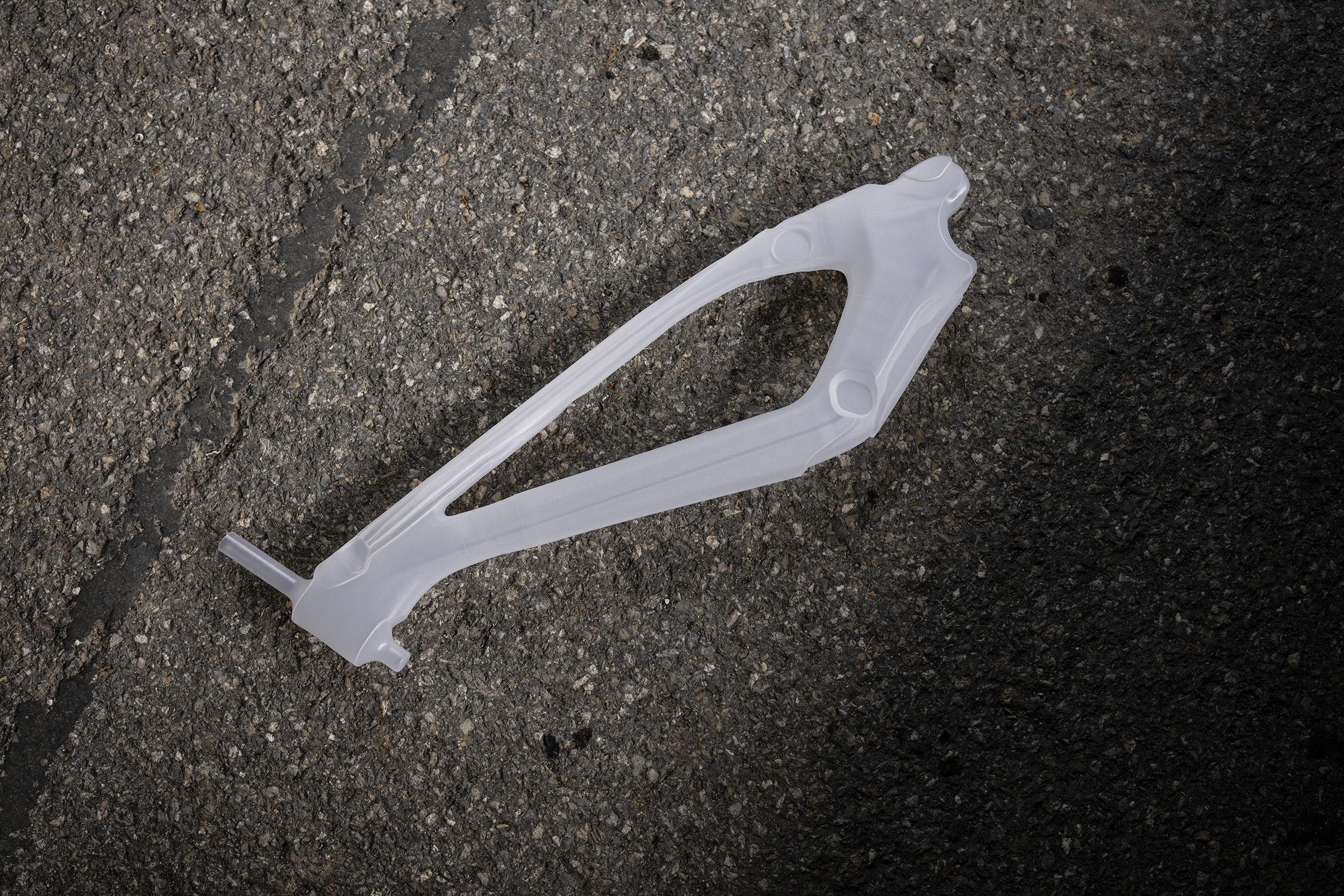
This male polypropylene mould gets wrapped with the carbon layup (there are also voids for the tube-in-tube cable guides) before being placed in the mould, pressurised, and cured in the oven. The insert is cut out and removed from the final piece.
Scott has always been at the forefront of carbon technology – it was one of the early adopters back in the ‘90s – and the Gambler makes use of its most advanced moulding process. Here, the pre-preg carbon jigsaw is laid onto (rather than into) a removable one-piece polypropylene insert before it is placed into the mould. This gives superior control over internal surfaces and allows for a more consistent finish than bladder or EPS methods.
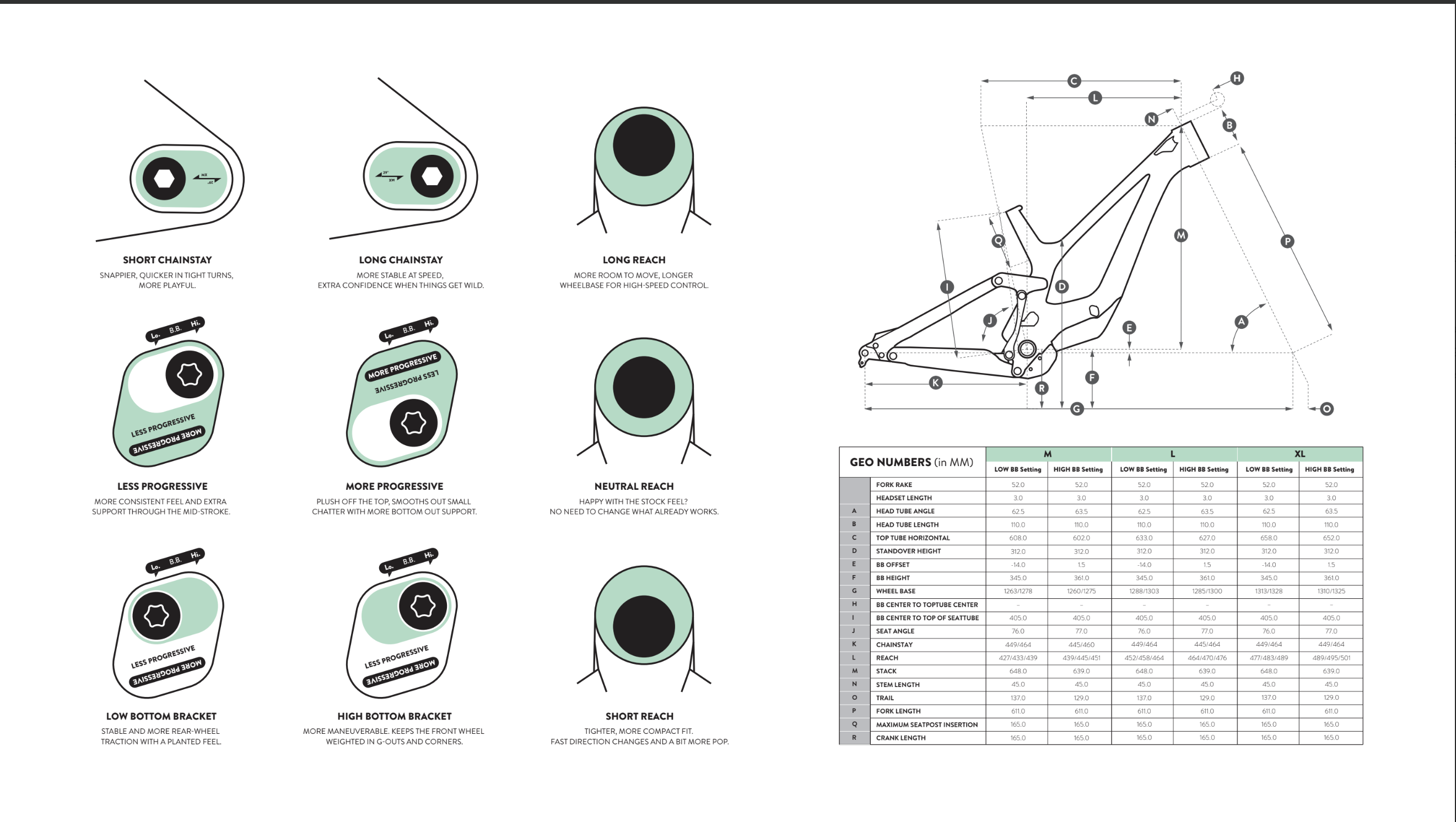
Choose your own adventure. The Gambler offers a bewildering array of configurations.
I’ll talk more about this later on, but if you suffer from decision paralysis then the new Gambler could be triggering. In order to optimise a single bike for different riders and multiple race tracks there is an almost overwhelming range of adjustments on offer. There are three reach lengths per frame size, two BB heights, two chainstay lengths, and two progression settings for the shock. The bike can also be set-up with either a 29in or 27.5in rear wheel. If my maths is right then that’s 36 permutations for the MX set-up and 18 for the 29in (you can only run the long chainstay with the larger rear wheel). Enough to frazzle even the geekiest brain. And that’s before exploring damping settings, spring rates, fork crown heights, bar rise, tyre pressures and any number of other customisable parameters.

Around the BB is the sagometer, which is an extremely useful tool when setting up as it gives both axle sag and overall travel insight.
At least Scott has taken one annoying ambiguity out of the equation. Around the BB is a sagometer that makes precisely setting static sag a doddle even with a coil shock. What’s more, it represents actual travel at the axle, not shock stroke. And even better still, it’ll tell you how much travel you’ve used – something that’s virtually impossible to know on a coil equipped bike without some kind of datalogging equipment.
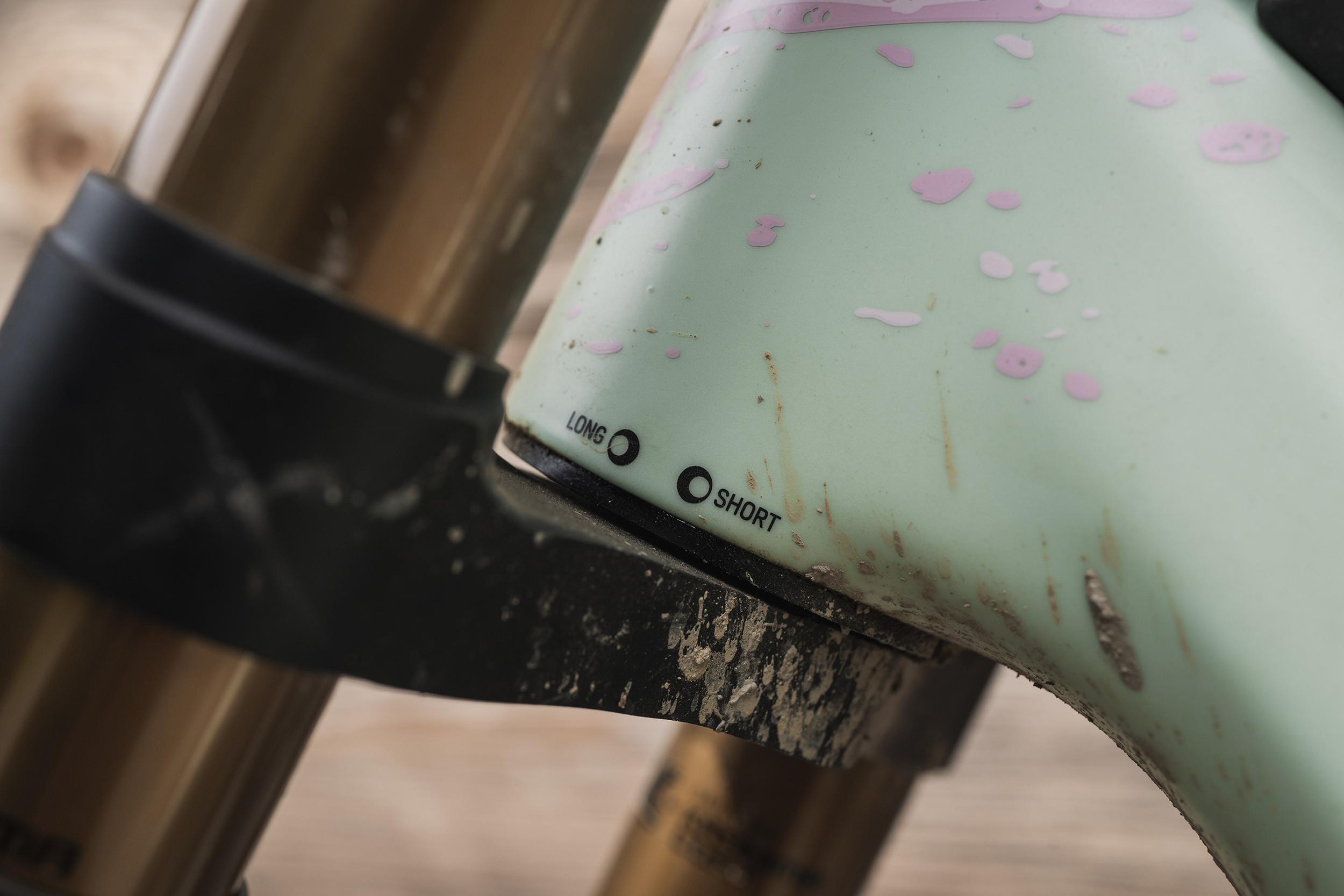
Neutral and offset headset cups give three different reach options on each frame size. Changing the BB height further affects the reach.
Sizing and geometry
Being the movable feast that it is, there is an immense amount of leeway with the sizing on the Gambler. Starting with the medium frame, you can run 427-451mm depending on the offset cup used and the BB height selected. Large frames can be arranged between 452-476mm, and the XL covers 477–501mm.
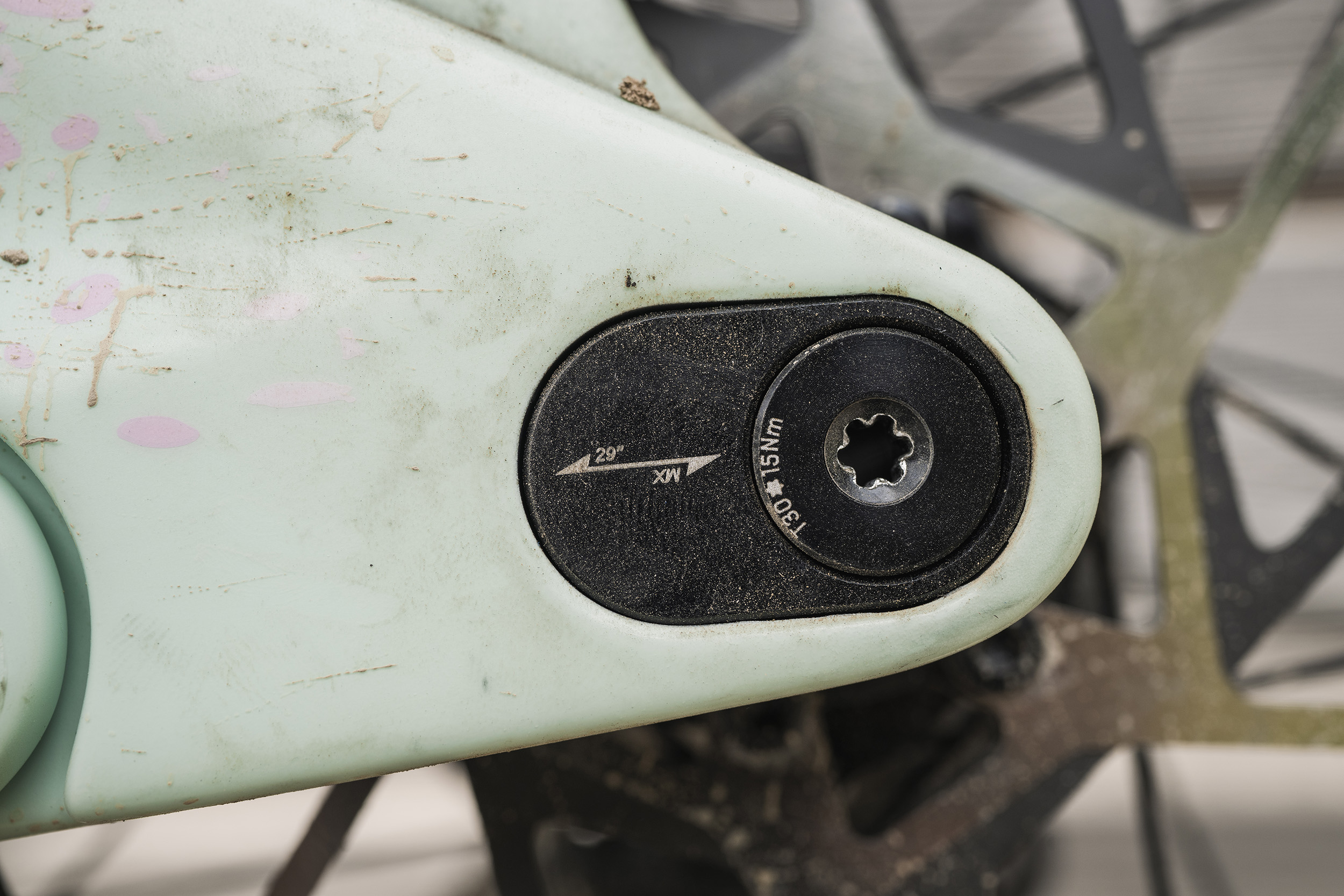
Flip chips give two chainstay lengths.
Initially it was quite a shock when I pulled out my test bike to find it was an XL. But with the cups in -5mm, that equates to a 489mm reach in the high BB position, and 477mm in the low, which seems far more reasonable given my 178cm height.
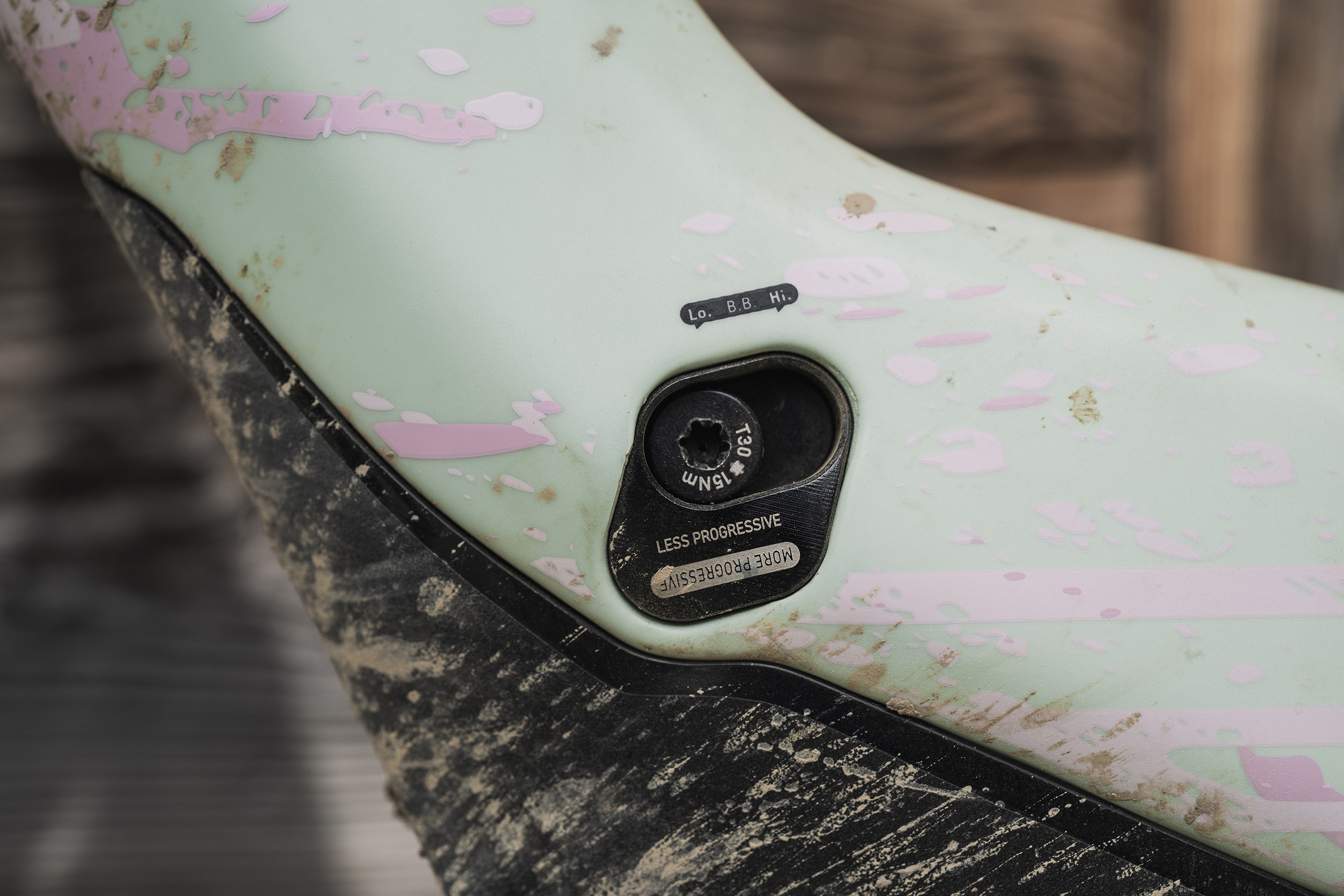
BB height can be adjusted by 16mm, while either 25% or 30% progression can be selected.
It’s almost pointless discussing the other measurements in isolation, but force of habit encourages me to disclose them for the record. Starting with the BB height of 345mm (low) or 361mm (high), chainstays of 445mm/460mm in the high setting, and a 62.5º head angle that steepens to 63.5º in the high BB position.
All the hardware seems designed to be easily configured in the pits using a Torx T30 tool, although having the luxury of several pro mechanics at my every beck and call meant I didn’t actually get hands-on to verify.
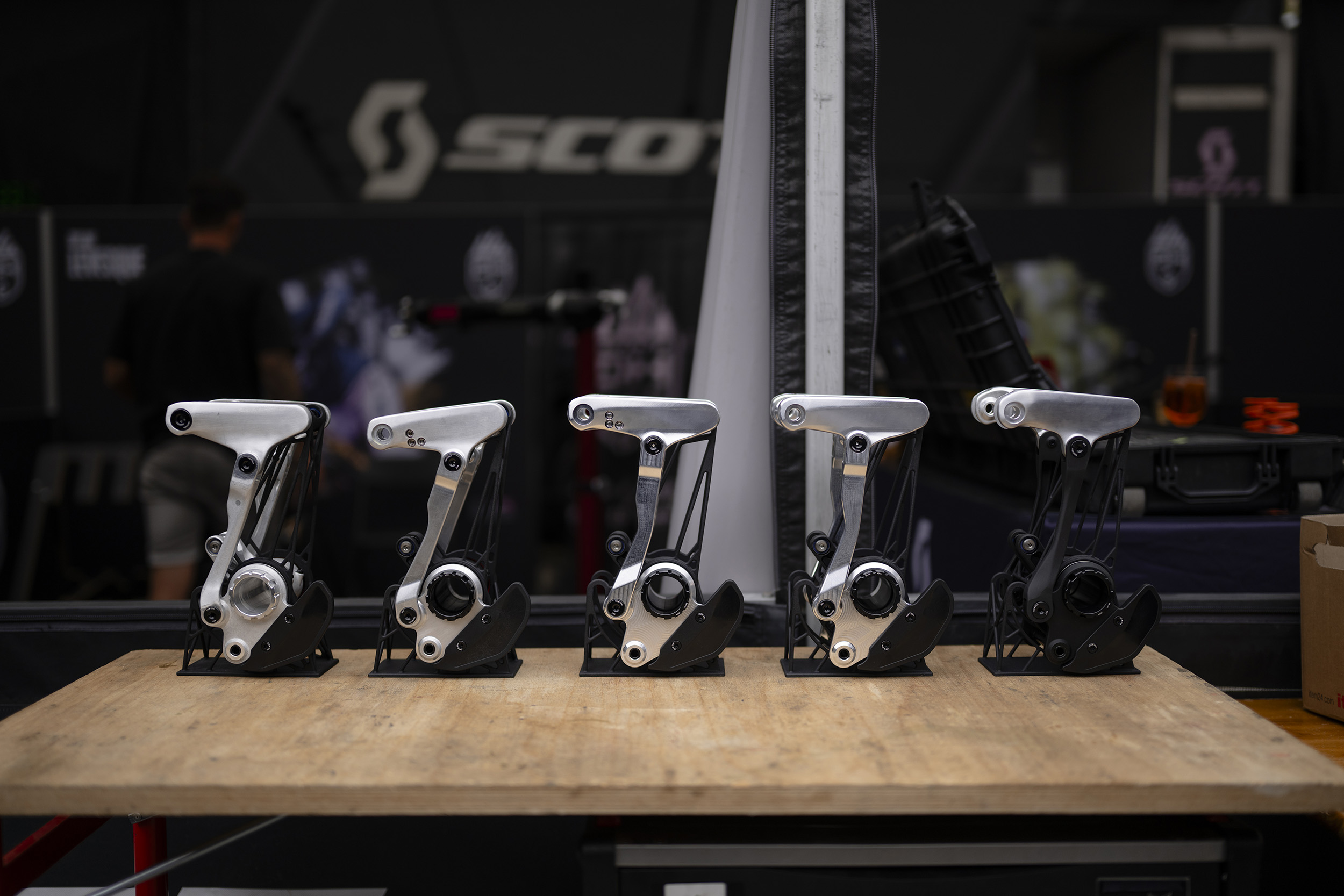
An array of linkage designs were built and tested during the development process.
Suspension
I asked the Scott engineers whether they would have chosen to run a six-bar linkage if they didn’t have to hide the shock within the frame, and they gave me a resounding “yes”. So while the complex arrangement of pivots, levers and connecting rods makes it possible to extract upwards of 200mm of travel out of a shock in such a confined space, there are sufficient extraneous advantages as to be worth the effort.
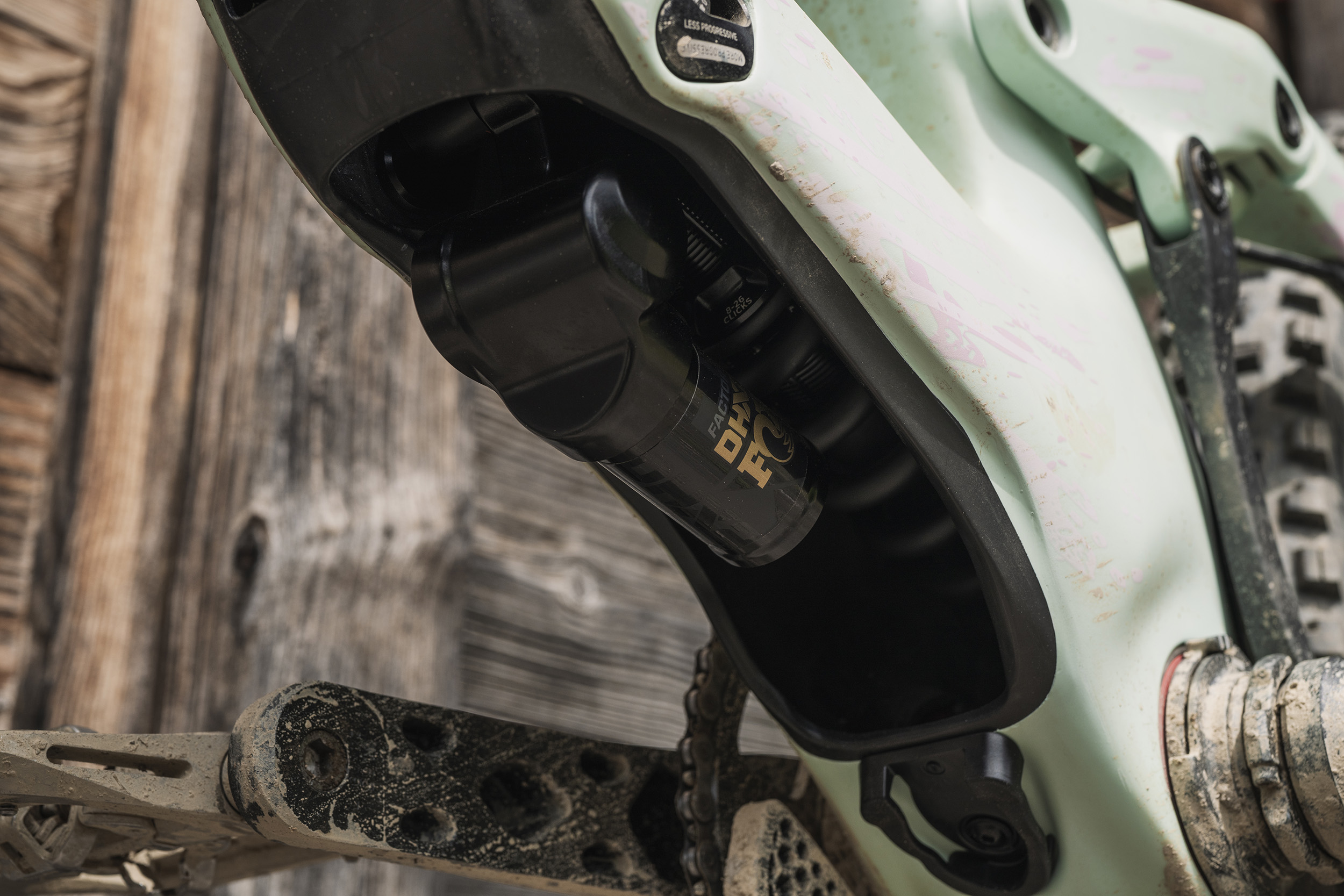
The guts of the Gambler on show. Scott’s cover forms a pretty effective seal against dust and dirt, helping to extend service intervals and simplify cleaning.
One such advantage is that the shock can be effectively isolated from frame flex. Allowing the suspension to be consistent and unimpeded, while the engineers independently configure the chassis stiffness. It’s here that I should mention Scott’s bike flex library. Comprising seven different bench measurements, along with rider feedback, this is a resource built up from Scott’s own back-catalogue, supplemented by competitor frames, to help define a sweetspot between accuracy and predictability on the one hand, and harshness and deflection on the other.
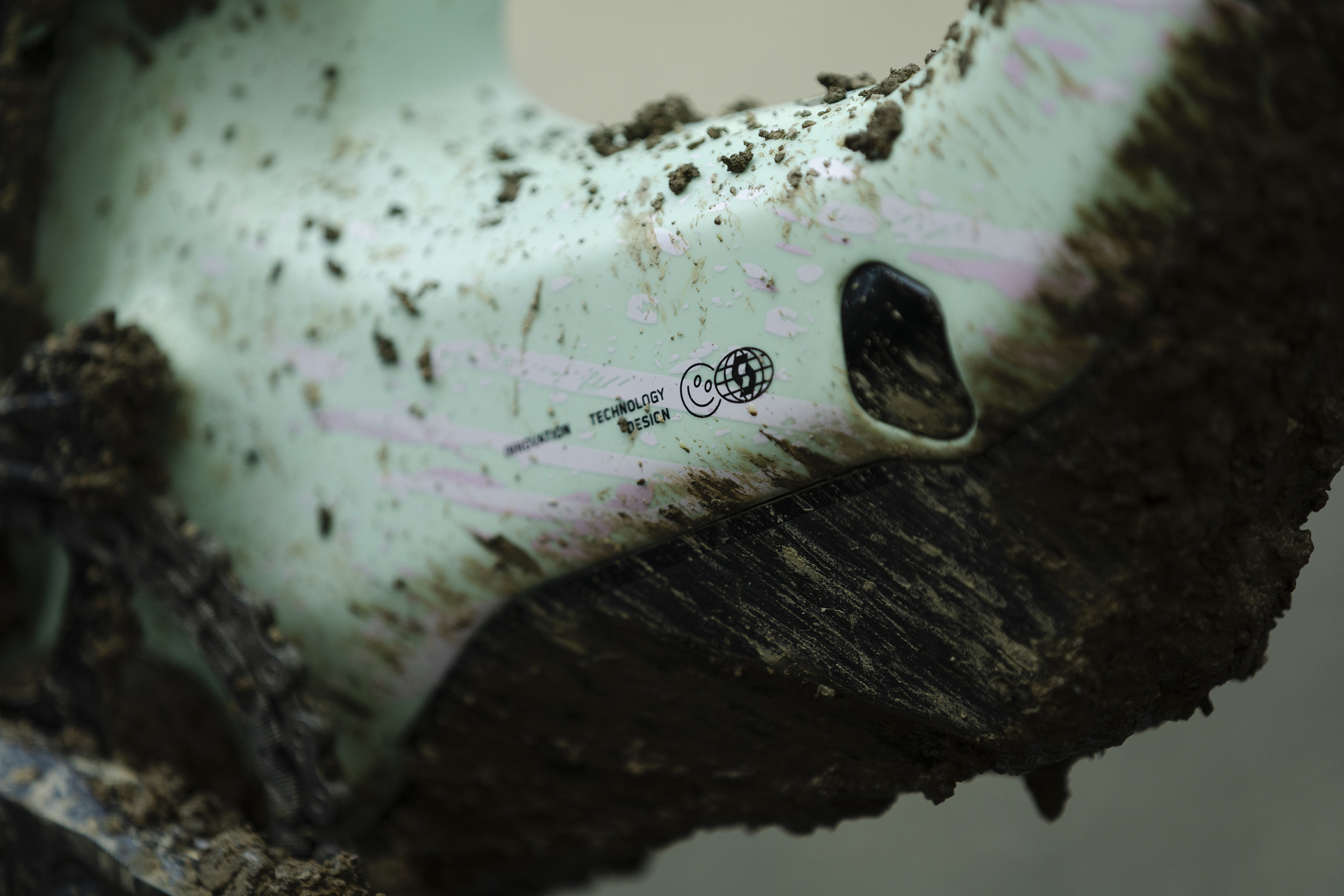
Normally all this would be covering your shock.
Another benefit of the six-bar design is that there is considerably more scope to tune, say, the leverage curve without compromising on the anti-squat. In other words, different kinematic attributes can be honed individually.
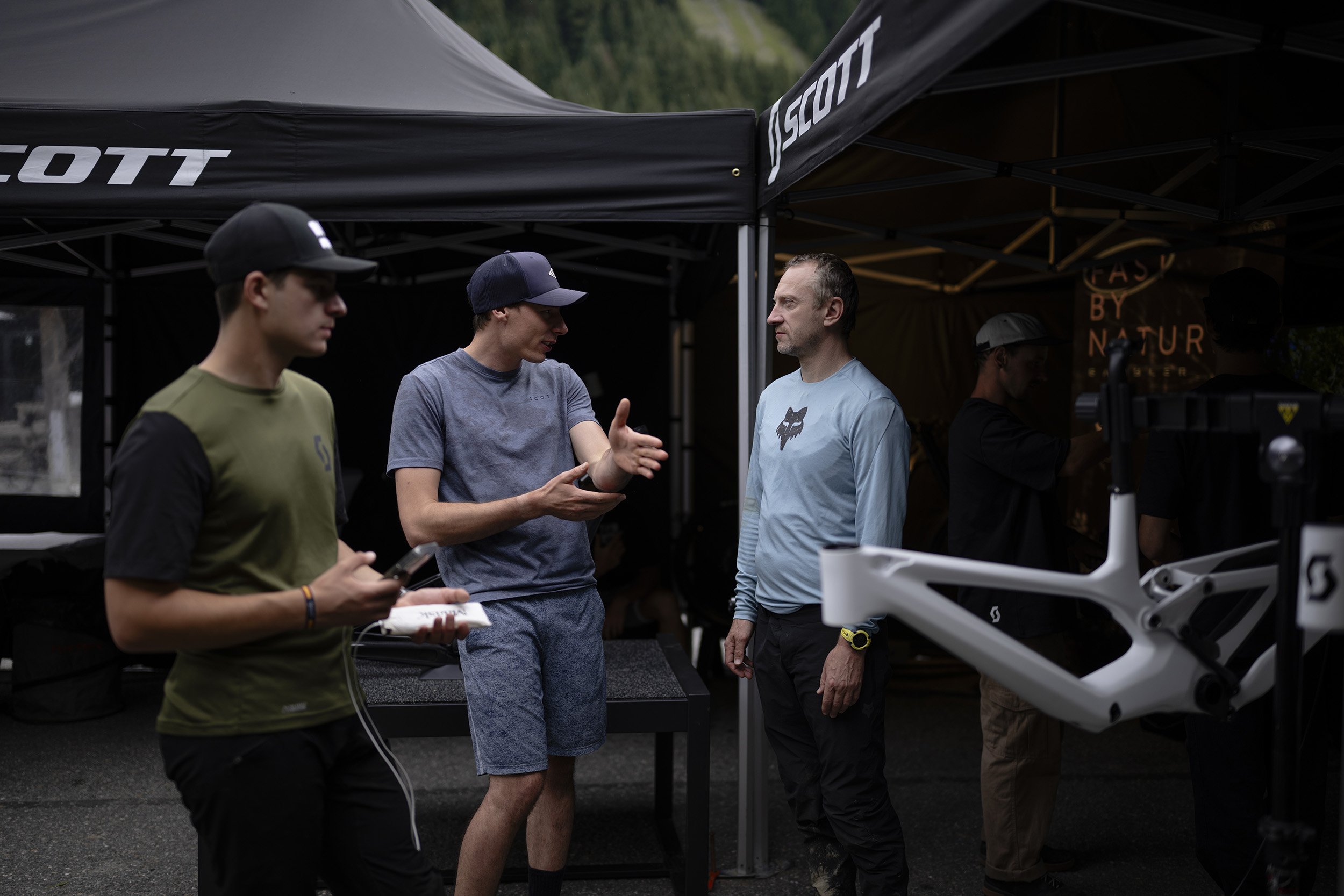
Benoit recounts his story about a shark encounter. Maybe.
The finished Gambler evolved through at least five different configurations of linkage during the development phase, with Benoit Coulanges being instrumental in pushing the process forward when he came on board at the end of 2024. A habitual tweaker, Benoit racked up a colossal 170,000m of descending on a single test mule during the off-season.

Does the new Gambler have the cool factor of a V10, or the sleek good looks of the Orbea Rallon?
Components
Scott is offering just complete builds and I got to ride the top end RC model, designed to be race-ready straight out of the box. This gets you a Fox 40 Factory fork and DHX2 Factory shock with SRAM Maven brakes and SRAM X01 DH 7-speed drivetrain.
Wheels are Race Face’s Atlas set, shod with Maxxis AssegaI/Minion DHR II tyres in DH Casing. However, I would have liked to see Scott match the Maxx Grip compound both front and rear.
Claimed weight is 16.84kg, which is pretty light if you’re used to riding e-bikes, as I am!
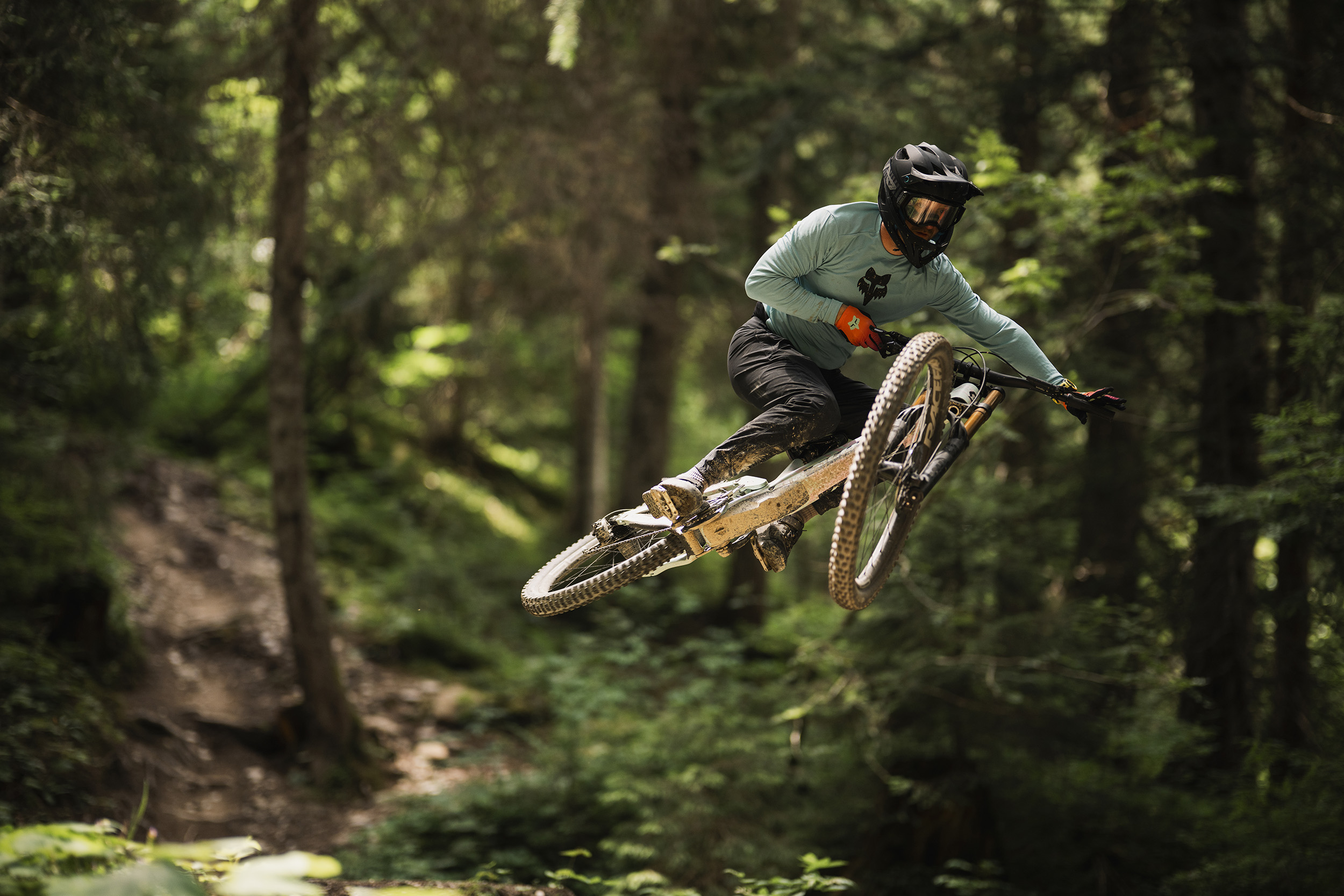
The Gambler felt lively and biddable on flowing bike park runs as much as it felt capable on rowdy sections.
Performance
Being handed a race-ready World Cup bike and a lift pass to one of Europe’s premier bike parks is like being handed the keys to a F1 car and ushered through the gates of Silverstone. In other words, equal parts chilling and thrilling. Even knowing where to start on a bike with so many permutations is bewildering. How am I supposed to impart any meaningful feedback on a tool designed to operate at the very edge of what’s capable for a human on a bicycle? To say I was suffering from imposter syndrome would be a grave understatement as I sat on the lift on the way up to my first lap.
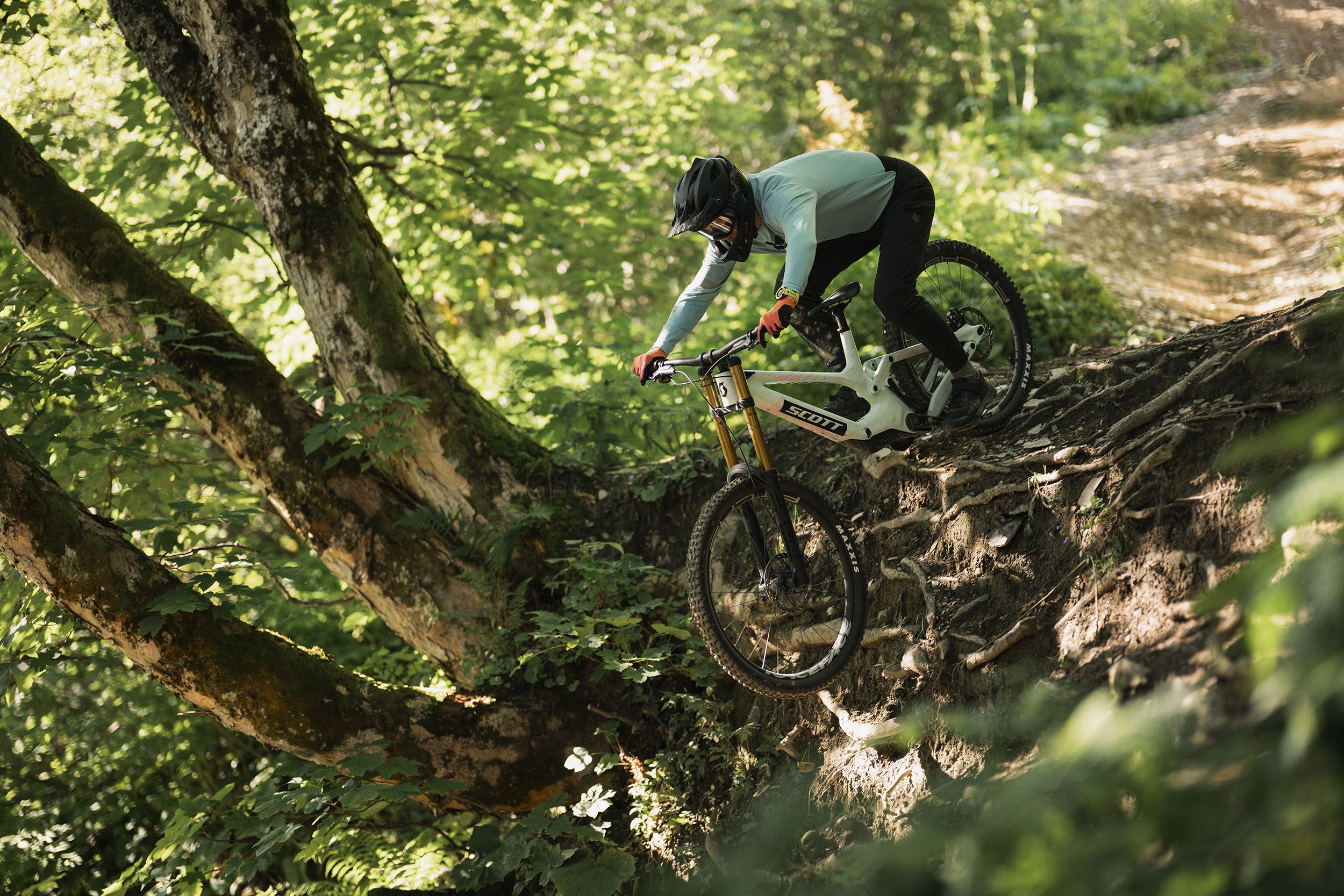
The entrance to Bike Patrol is a rooty drop/roll-in.
But I had a plan. Pick one track and ride it as many times in as many different configurations as possible until I was either exhausted, crashed my brains out, or the lift had stopped running.
So, eschewing the multitude of tracks funneling down the Chatel mountainside, I made a beeline for the trail known as Bike Patrol. I chose this track, not only because it’s steep and mostly natural with an overabundance of roots and a wild rocky section in the open, but also because I’d spent two days riding it in 2008 at a previous Scott Gambler launch. Yes, I’m that old. Perhaps the old muscle memory would kick in and help speed the process up of learning the track? One can hope, I thought.
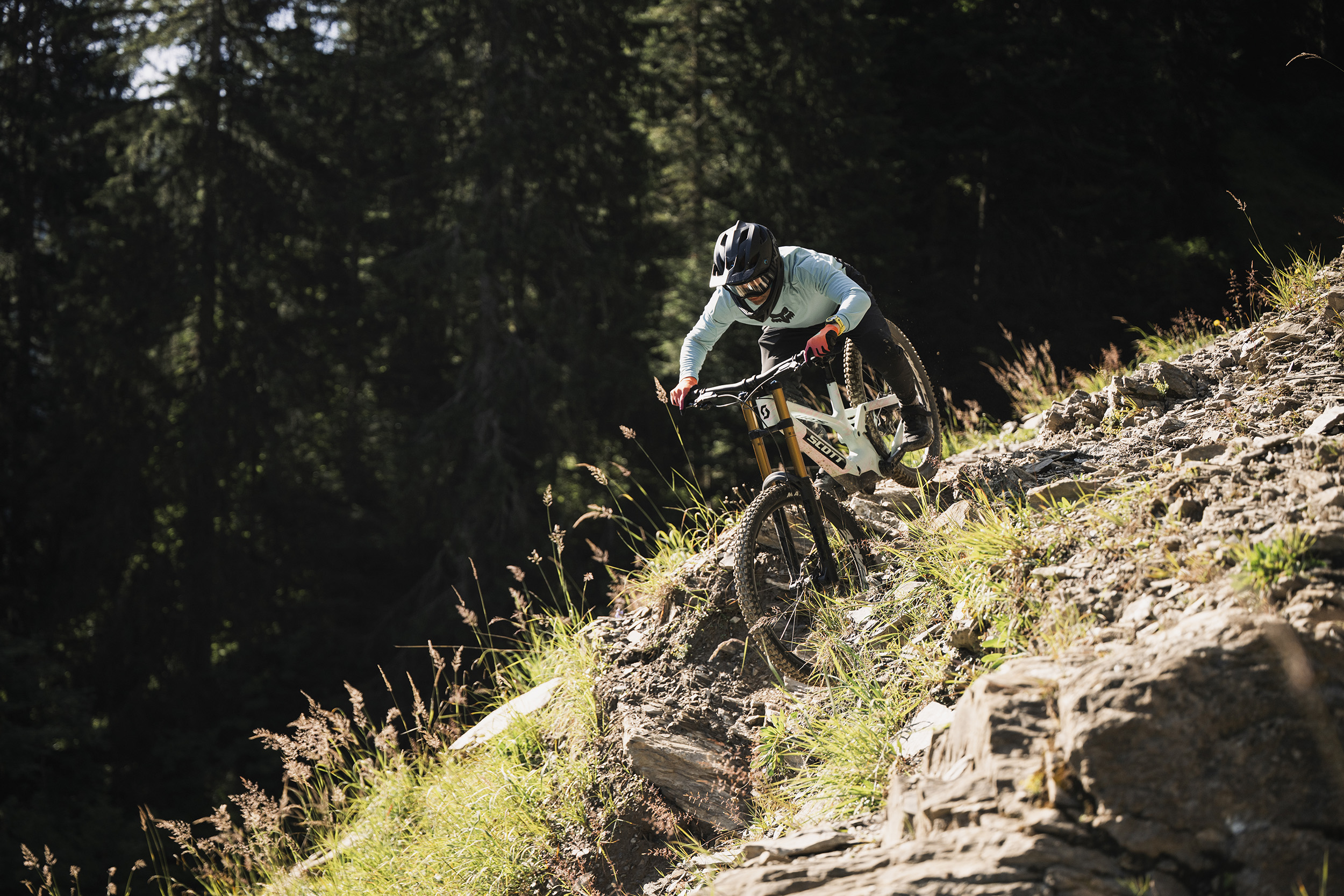
The signature section of Bike Patrol is in the open, on a series of steep, shale chutes.
And you know what, it worked. The first runs were slow and cumbersome. I dribbled over the roots, seesawed over the drops, and took all the low-lines that gravity and the slick layer of surface sheen sent me down.
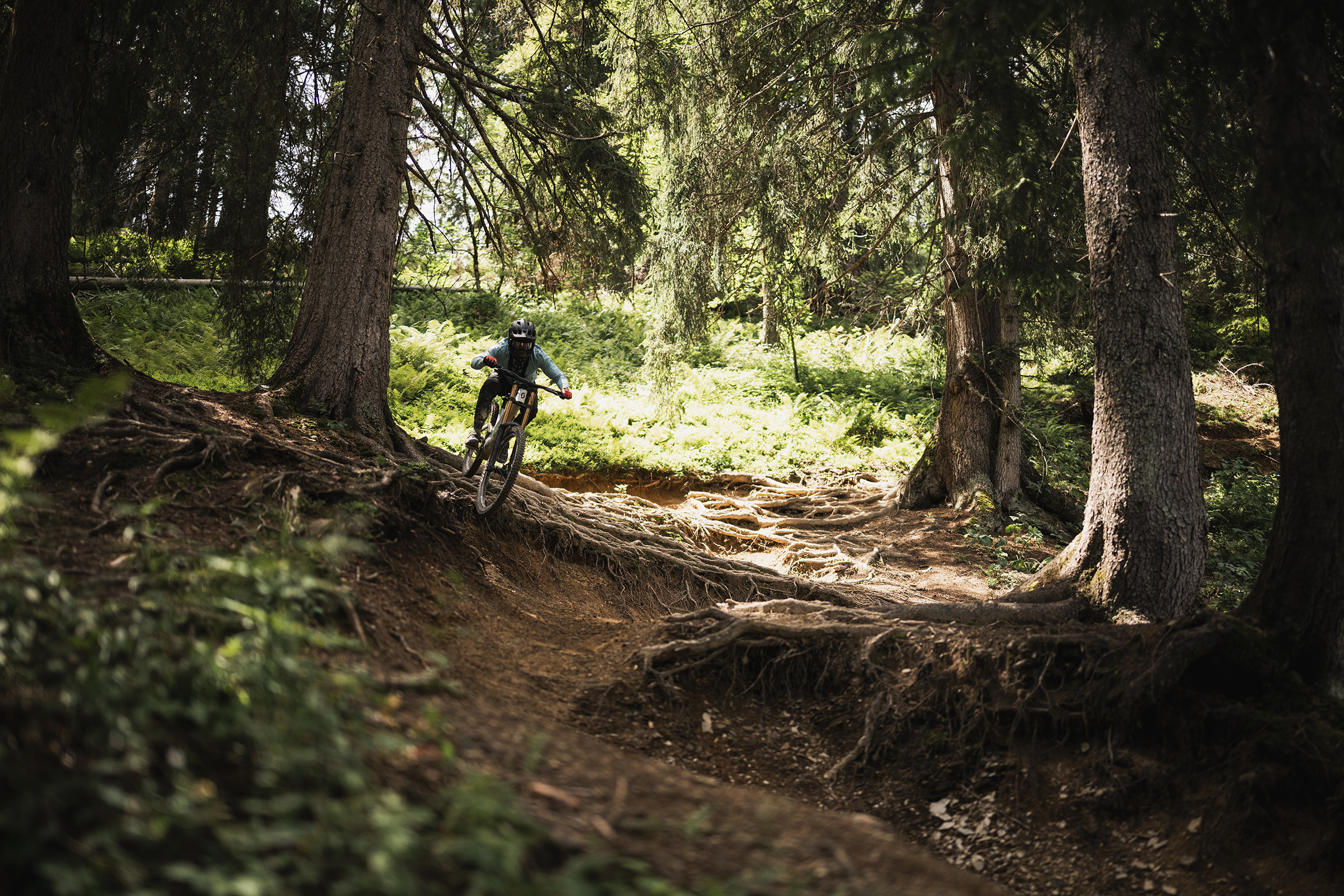
Oh, and it has its fair share of roots, too.
To begin with the bike felt like it was working for the other team. My feet felt too high, my hands felt too low, and it was impossible to know whether it was the bike pushing me into this position, or I was backing away from the bike because I was scared and non-commital.
At this point it’s easy to fall into the trap of changing too much, too soon, so I dropped the BB height and left it at that, keeping the short chainstay setting and less progressive shock position.
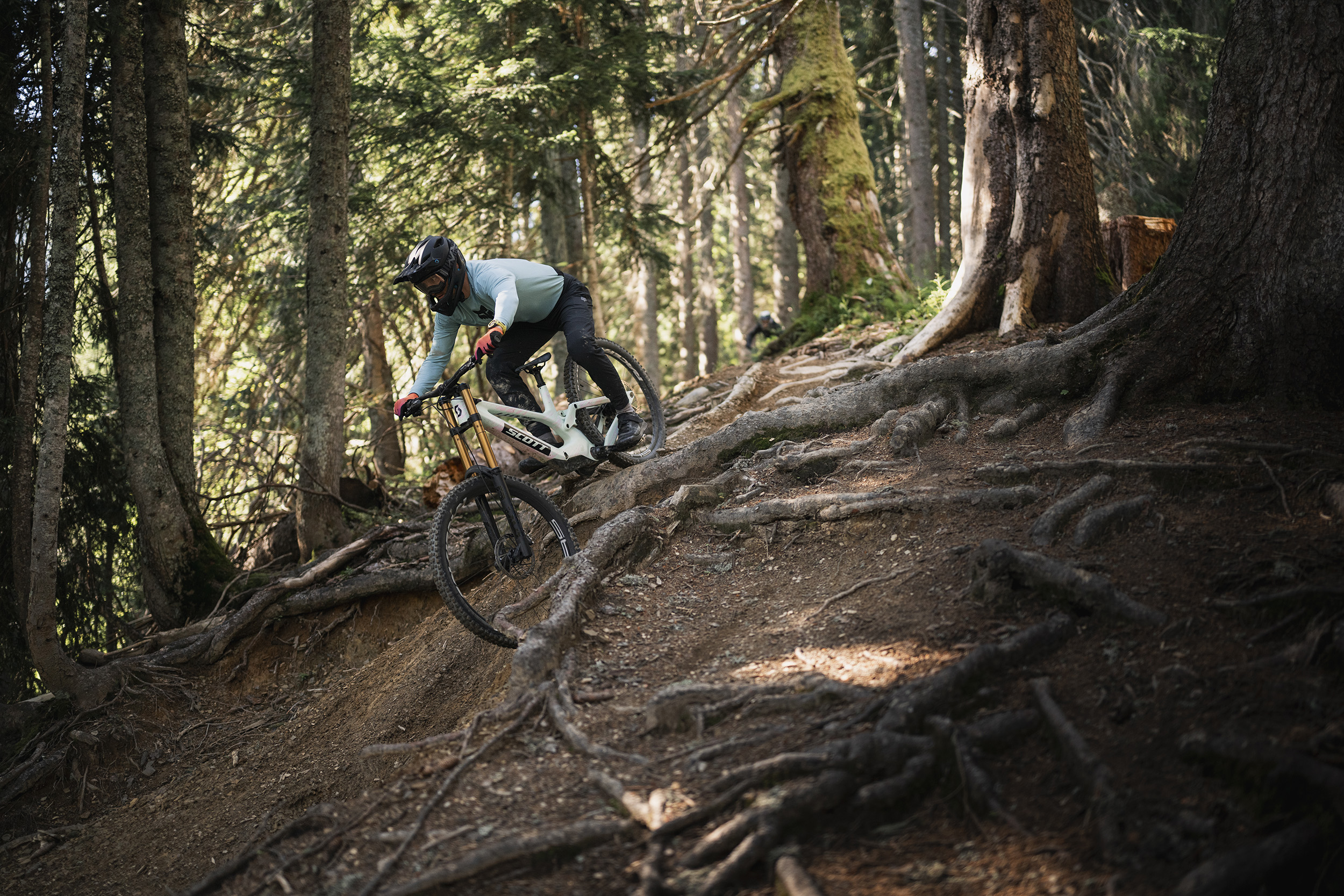
Some of which are genuine anacondas.
Now the Gambler started to feel easier to get hold of, like I was nestled in the bike rather than being ejected from it. Lines were starting to make sense, and rather than a stop/start series of jerky convulsions, my laps were beginning to flow. I was picking my lines, carrying speed over the worst of the jank and feeling considerably more at home.
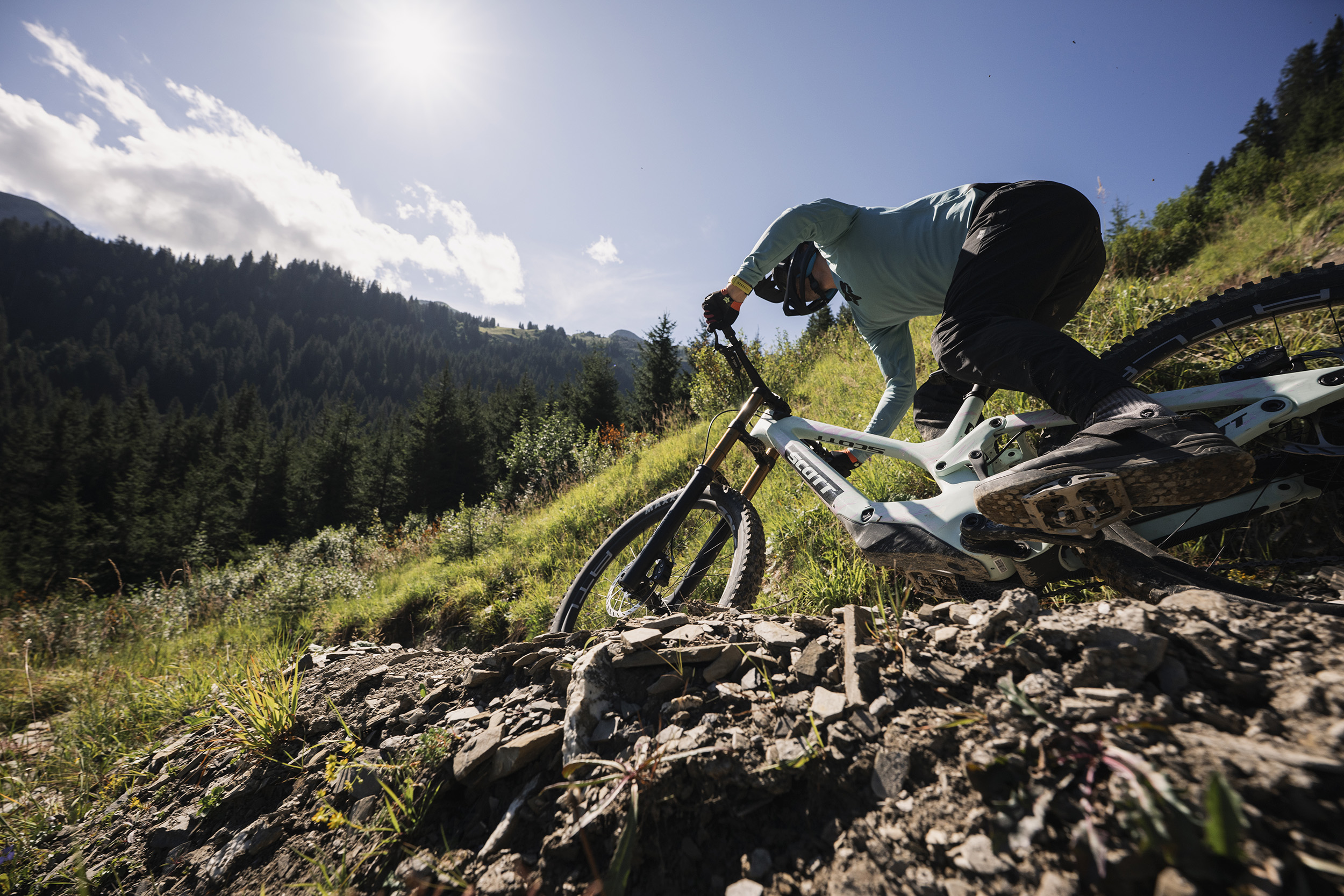
Getting into the groove on the Gambler.
It’s safe to say that the shorter chainstay option had helped me get to this point, as well as helping the bike feel easier to throw around on the flowing bike park berms and jumps. But I was not getting anywhere near full travel at the front, so I went to the longer chainstay setting with the aim of pushing more weight onto the fork.
Immediately the bike felt softer, even riding out of the car park. Of course the longer CS also increases the travel, and the leverage on the shock, so without changing the spring I was a little deeper into the travel, also lowering the dynamic BB height.
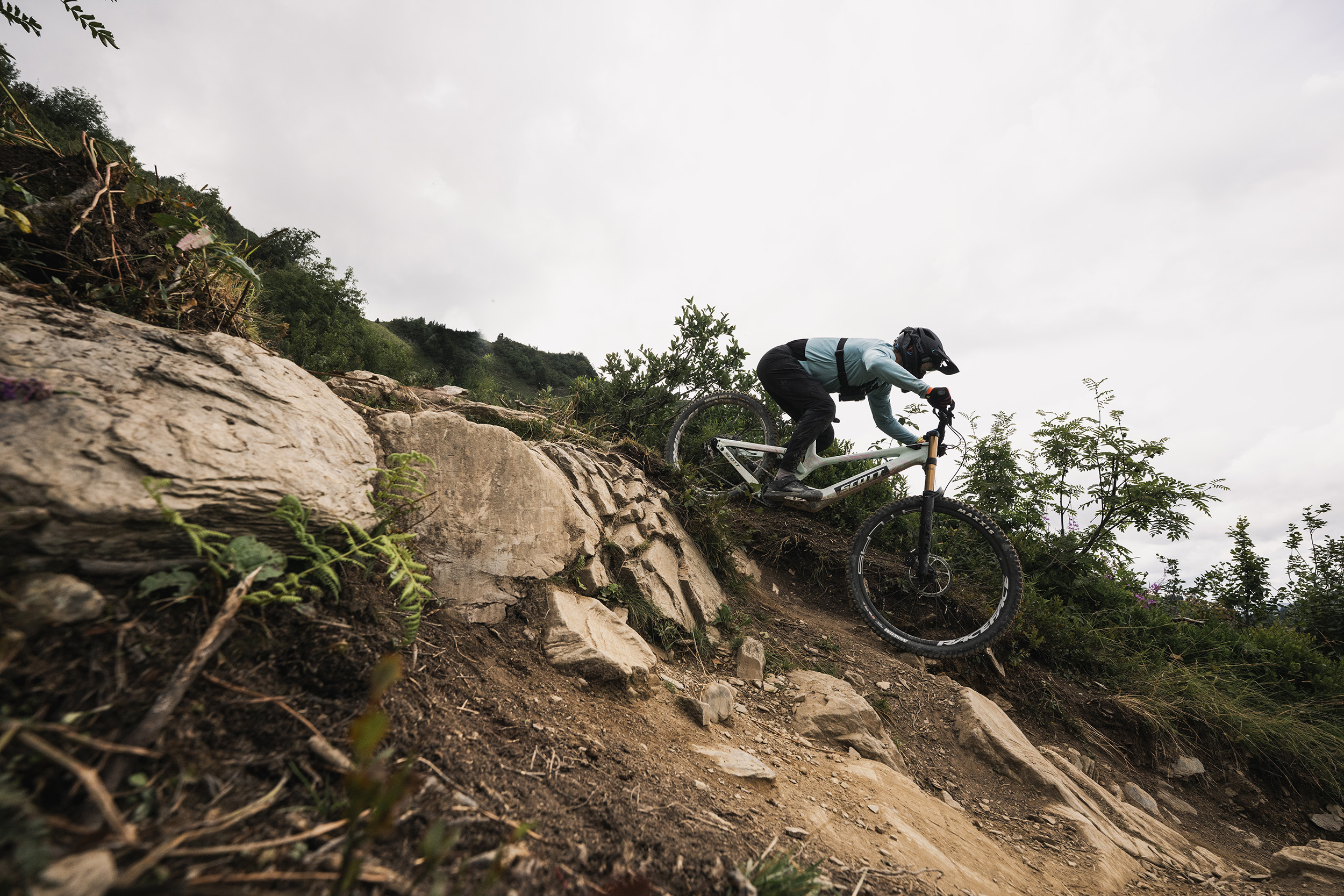
A day and a half was not enough to try all the Gambler’s permutations.
Both these factors, combined with a general increase in confidence, kept the set-up trending upwards. And it was here that I ended the day, having unlocked full travel front and rear, and feeling significantly more composed and confident on the Gambler. For a thorough-bred race bike, I found it impressively easy to ride and approachable. It was responsive when I wanted accelerations or direction changes, but planted and settled when security was at the top of my priority list.
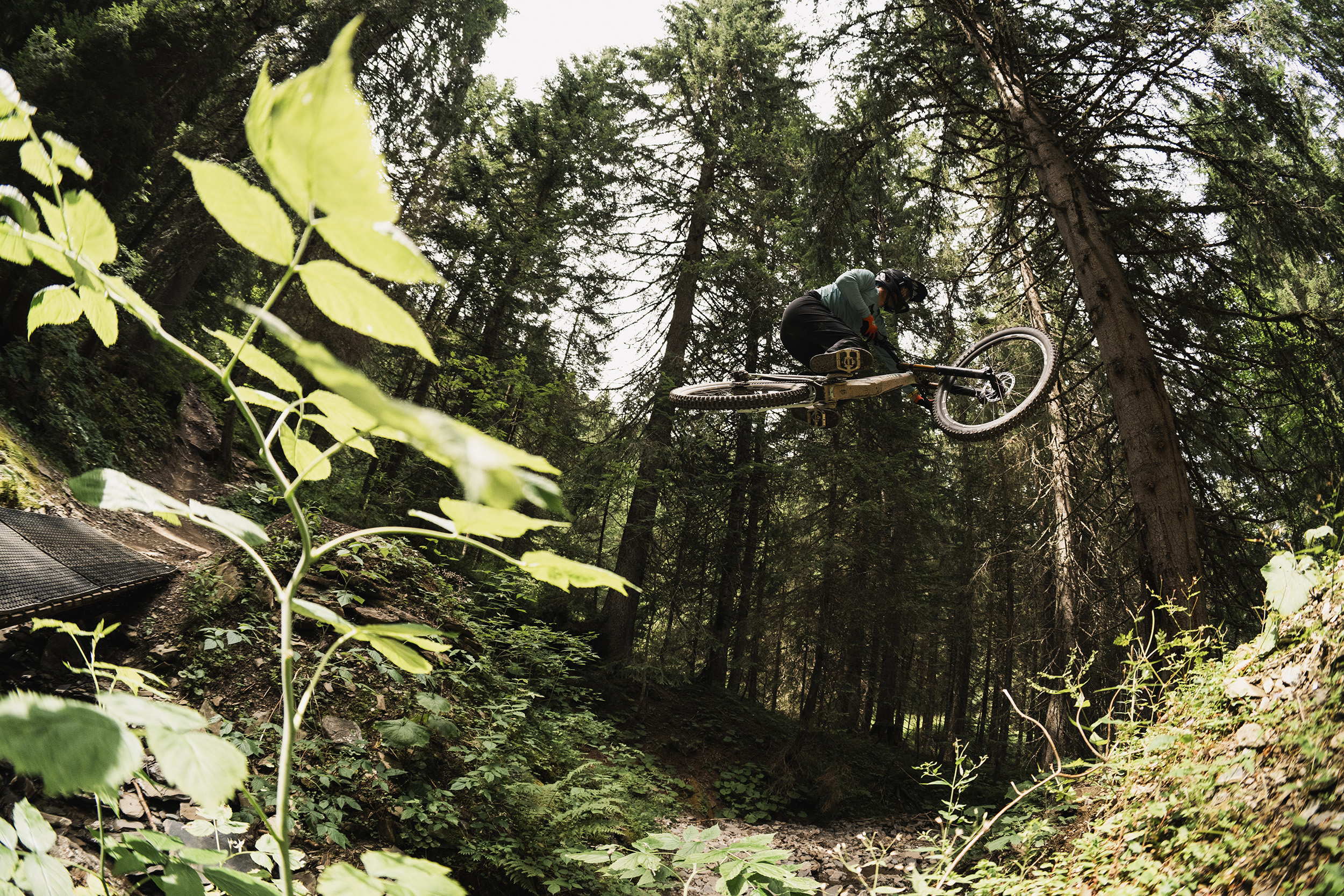
The only creeks on the Gambler were gaps.
Making adjustments was easier than you’d expect given the hidden shock, helped by the genius idea of incorporating a multi-tool into the shock cover to access the damping dials. And it was supremely quiet thanks to the secure cables and rubber frame protection.
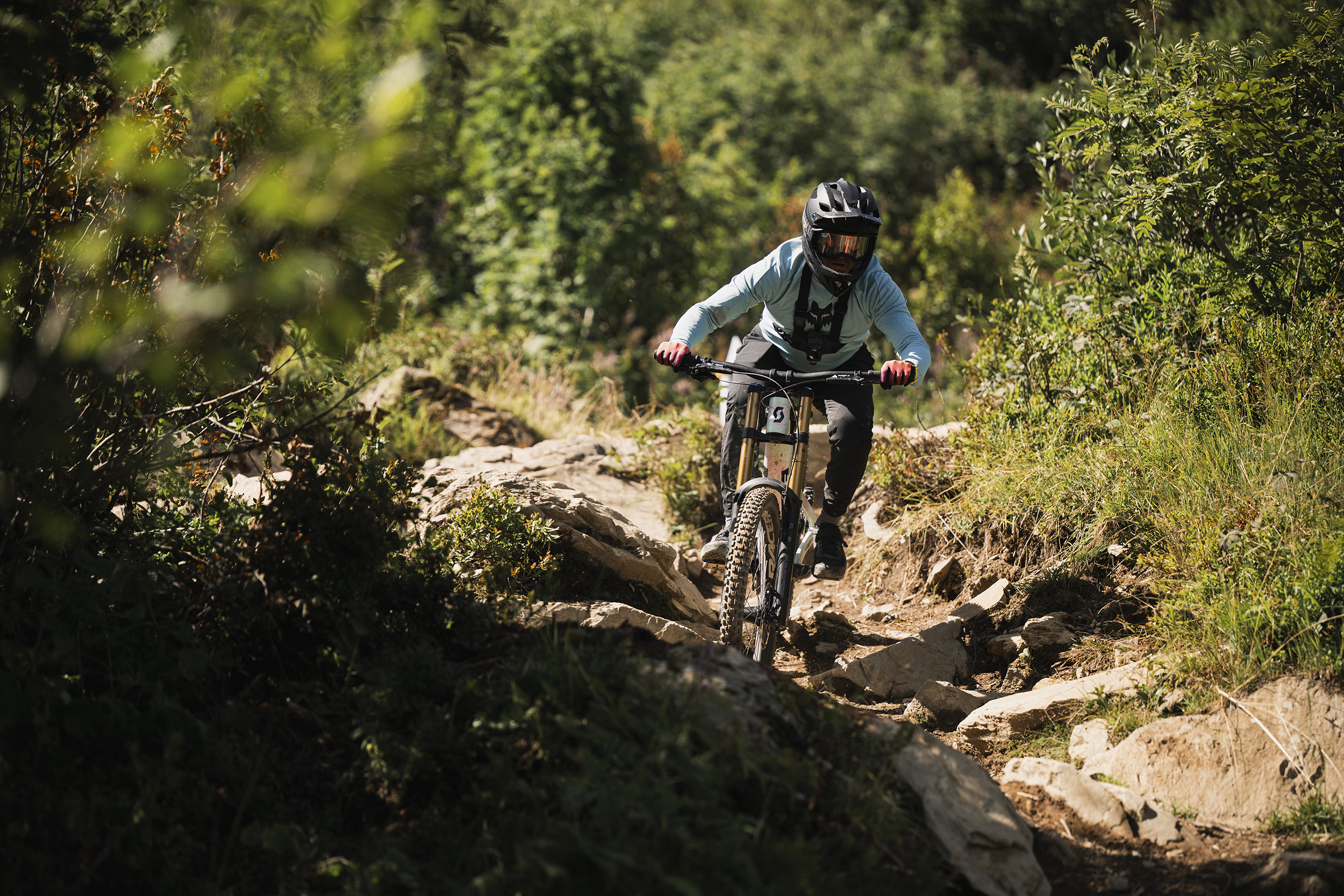
Still some way off full travel at this point, but I got there in the end as the speeds increased and I started hitting stuff harder.
Complaints? I found the Fox 40 a little harsh compared to the DHX2 coil shock, but I have a hunch the 2026 fork will include a number of revisions to help in this regard. And I would have preferred to see a Maxx Grip rear tyre as standard, as the discrepancy in braking traction is all too obvious on a greasy Swiss mountain side.
Sadly the rains came on day two, so although I tried the more progressive shock setting, it was impossible to compare like with like.

Towards the end of the day I was feeling much more at home on the trails and the bike.
In the end I did ten runs of Bike Patrol, tried four different geometry settings, and two different spring rates, and found a nice balance that felt totally comfortable. The mad thing is, that’s just a fraction of the options available.
Verdict
If you’re a privateer downhill racer without sponsorship, where do you put your money when it comes to a new rig? I’m sure most people would be looking at a Santa Cruz V10, a Canyon Sender, or an Orbea Rallon, but the Scott Gambler is a bike that deserves to be on that list too. It’s fast out of the box, but it has more options to shape it into your perfect race bike than any of those competitors, and when you’re chasing fractions of a second, that could make the difference between winning and losing.




